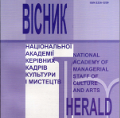«Мандри Сан Мао» Санбао: жанрова специфіка Китайського оригінального дитячого мюзиклу
“The Wanderings of San Mao” by Sanbao: the genre specificity of the Chinese original children's musical
Author(s): Zhaoyu JiangSubject(s): Music, Nationalism Studies, Sociology of Culture, Sociology of the arts, business, education, 19th Century
Published by: Національна академія керівних кадрів культури і мистецтв
Keywords: Chinese musical industry; Chinese original children's musical; short story musical; comic books; mixed genre; cyclical form;
Summary/Abstract: The purpose of the article is to determine the genre specificity of the Chinese original children's musical Sanbao "The Wanderings of San Mao" (2011), created on the basis of Zhang Liping's (1940) comics of the same name. Methodology - historical, comparative, genre. The scientific novelty of the study lies in the establishment of genre specificity of the Chinese children's musical. Genre specificity of the Chinese children's musical is distinguished both by its audience purpose and by the reinterpreted implementation of the features of comics of the same name, the reliance on which determined the storyline, the image of the main character, the dramaturgical features of the stage work. The general genre features of comics and musicals are systematized, the influence of graphic and literary prototypes on the musical "The Wanderings of San Mao", observed in the system of genetic, historical, genre, and content prerequisites are revealed. The content commonality of comics and musicals is embodied, in particular, in their genre names, which reflect their inherent comedic origins. The historical unity of comics and musicals is due to their gaining popularity since the middle of the 19th century. From a genre point of view, comics (based on the union of graphics and literary text) and the musical (based on the interaction of comic opera and operetta, vaudeville and burlesque, show and variety, ballet and dramatic interlude) have a mixed nature. The Sanbao musical seems to absorb the constituent elements of comic opera, adding them to the context of other genre components of the theatrical whole. Since comics are a kind of literary genre, it becomes possible to interpret them as the libretto of a children's musical. The scene of the musical as a self-sufficient variety number is likened to a drawing from a comic strip, correlated with coherent plot development, the story of the hero's life set out in the short stories. Inheriting the nature of comics as a sequence of drawings, the Chinese children's musical appears as a kind of suite cycle of musical and dramatic scenesnovellas from the life of the protagonist. The discontinuity of the musical's scene-narratives is overcome, as in comic books, by the story of the main character's adventures and dreams unfolding through the story. The author contrasting pictures of the short story musical are united by a thorough plotline, the role of the principle of "three unities" (events take place during one day in the slums of old Shanghai, where a simple child's dream becomes unattainable). Conclusions. The genre peculiarity of the Chinese children's musical "The Wanderings of San Mao" is conditioned, firstly, by the specificity of the audience; secondly, by the embodiment of Zhang Liping's comic book features as a graphic-literary prototype of Sanbao's musical and stage work.
Journal: Вісник Національної академії керівних кадрів культури і мистецтв
- Issue Year: 2021
- Issue No: 3
- Page Range: 244-249
- Page Count: 6
- Language: Ukrainian

